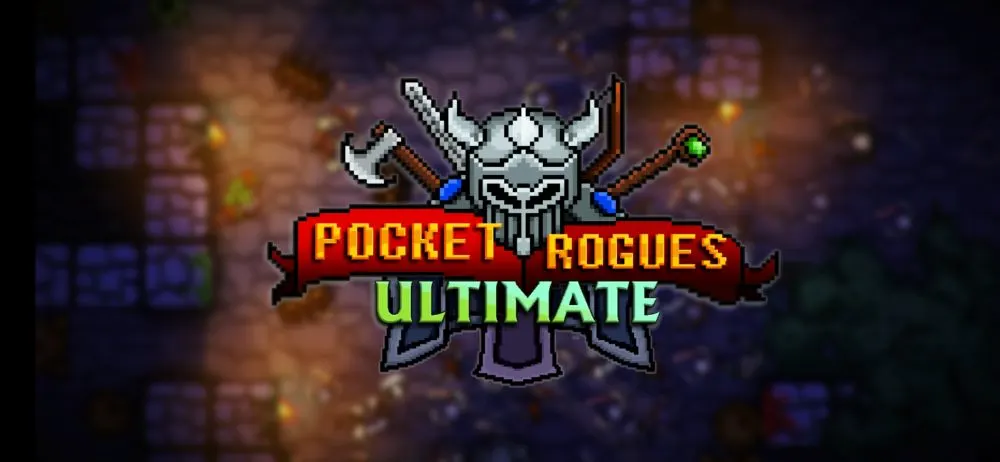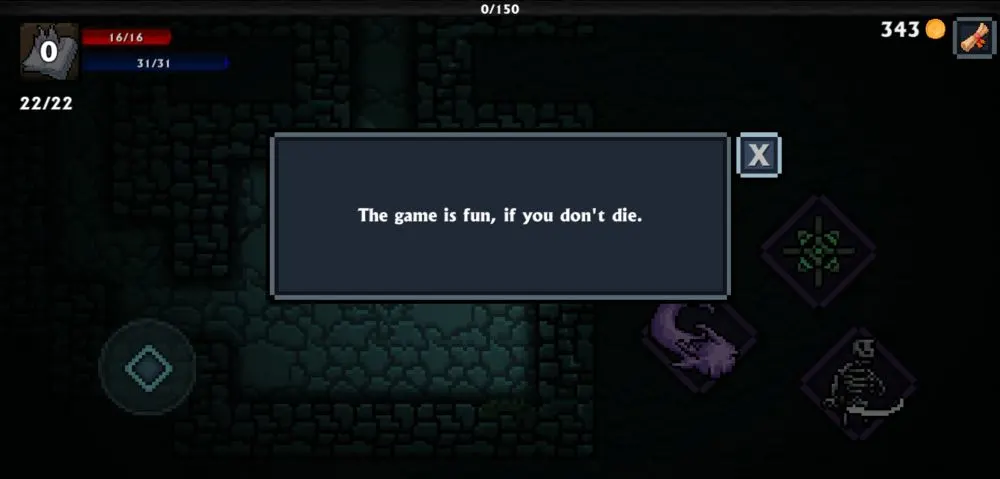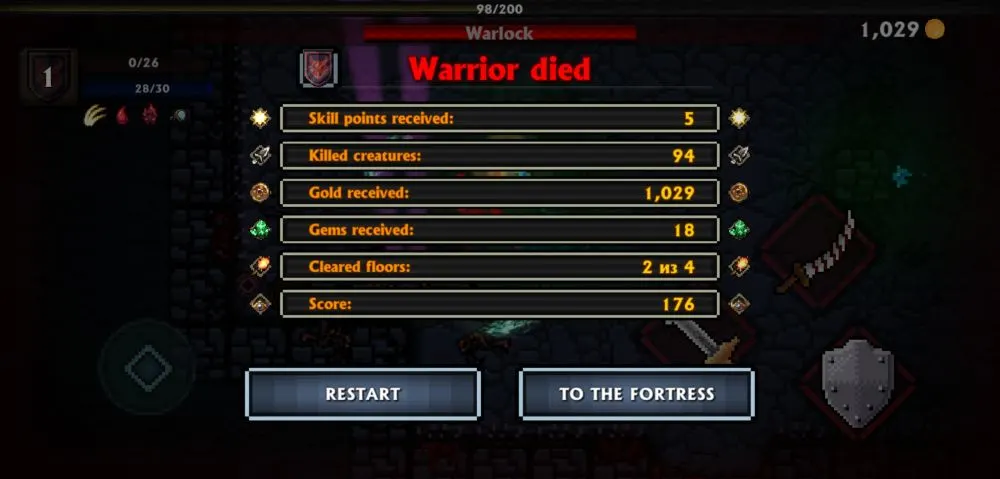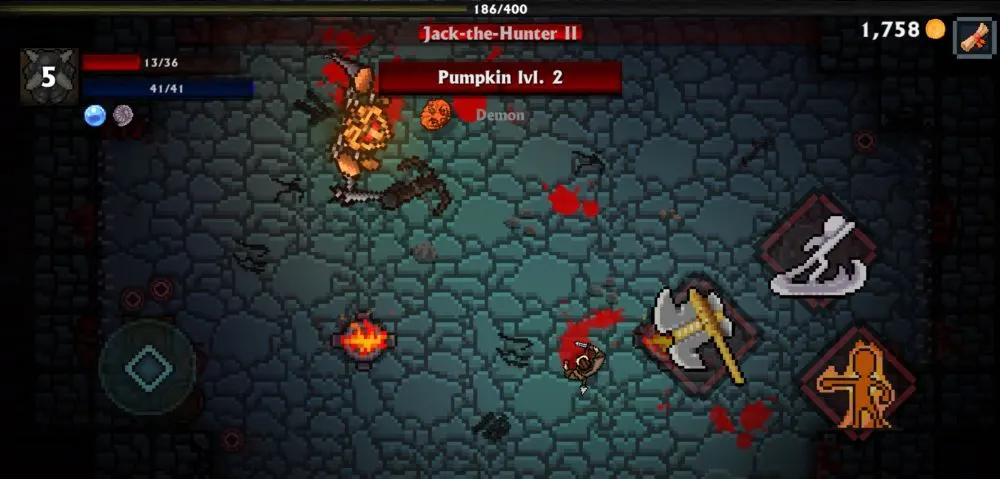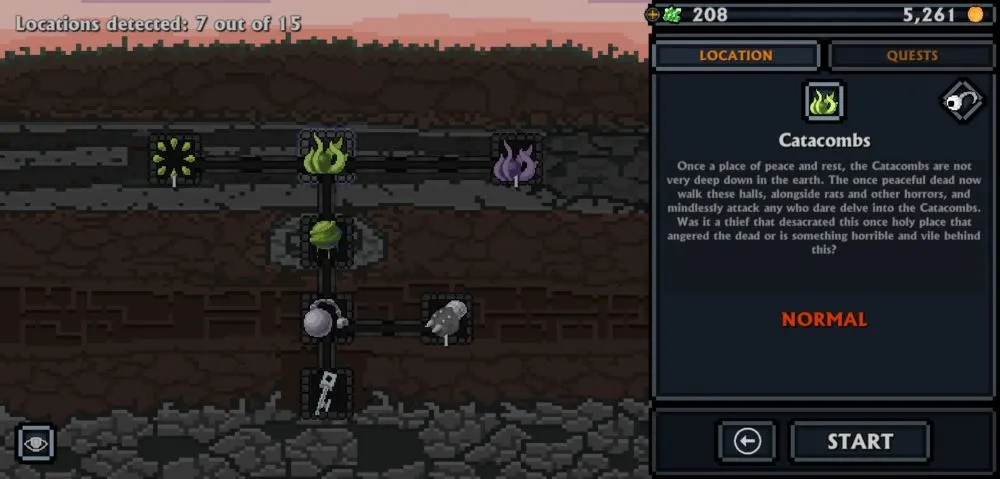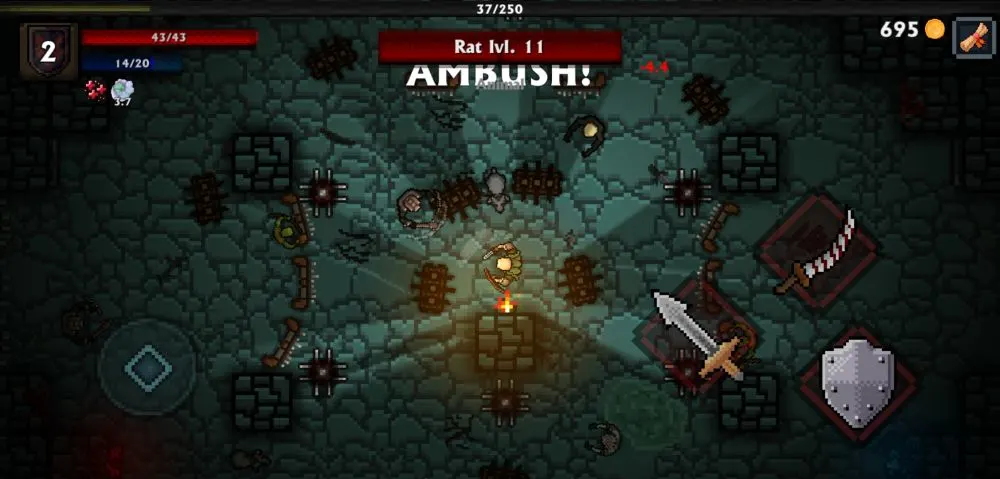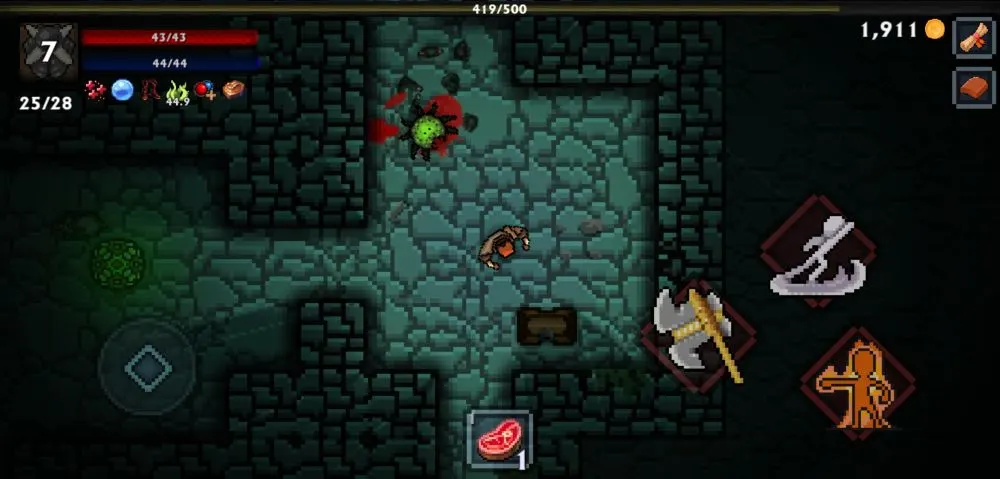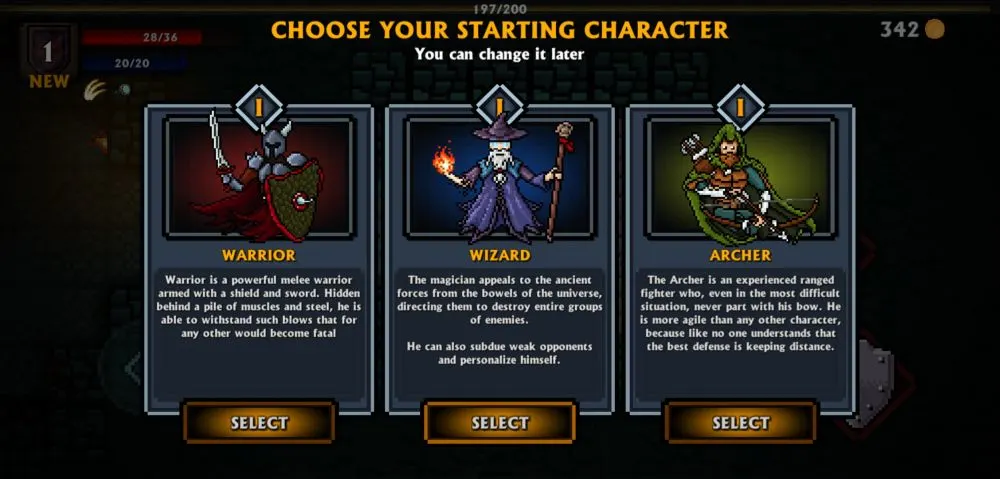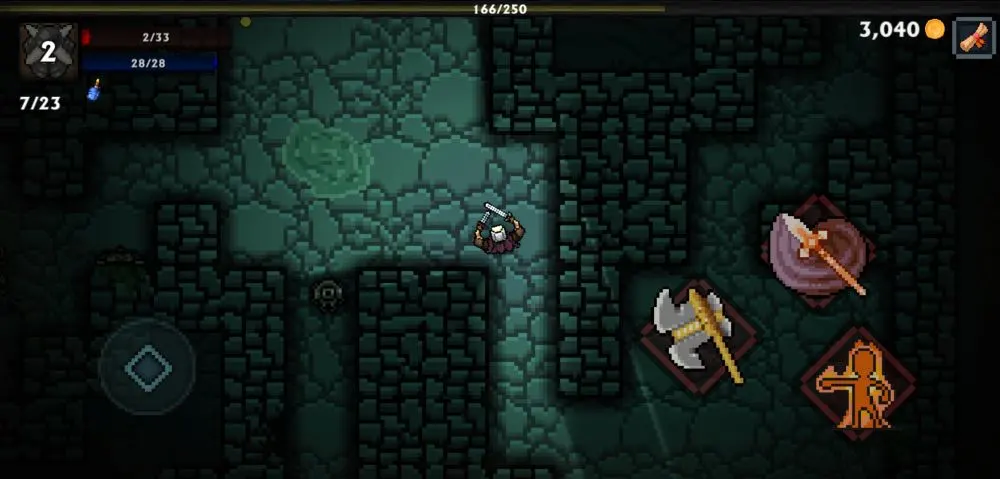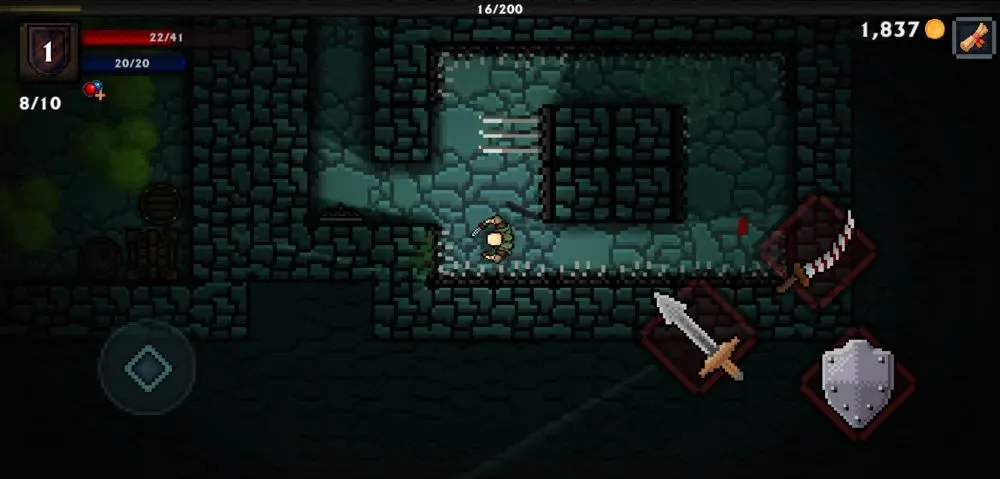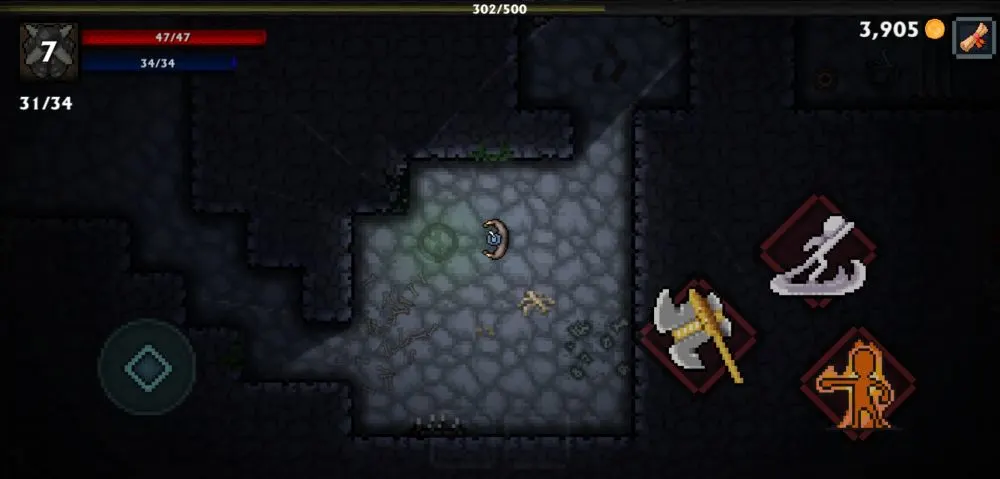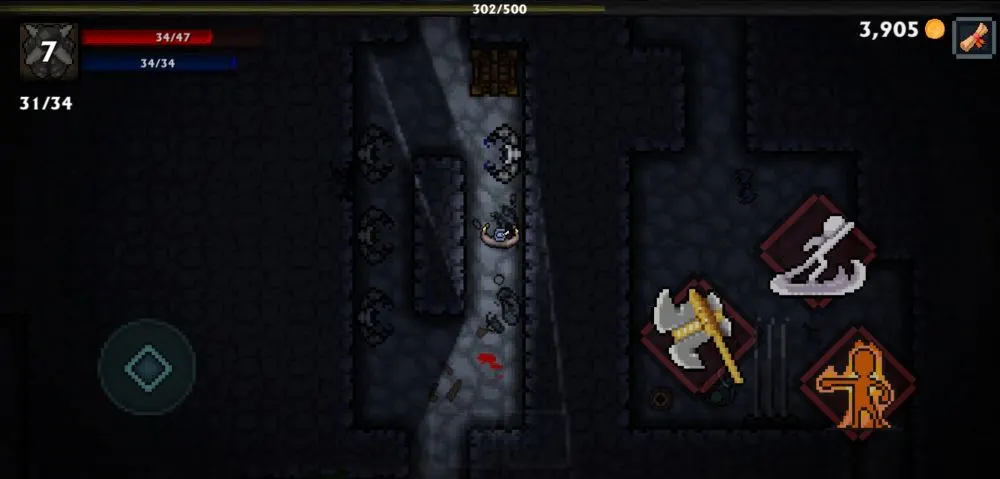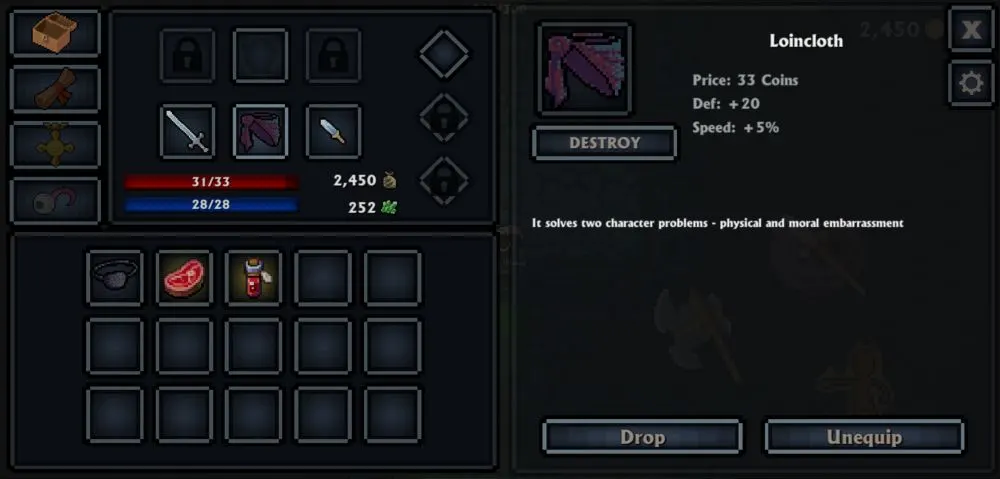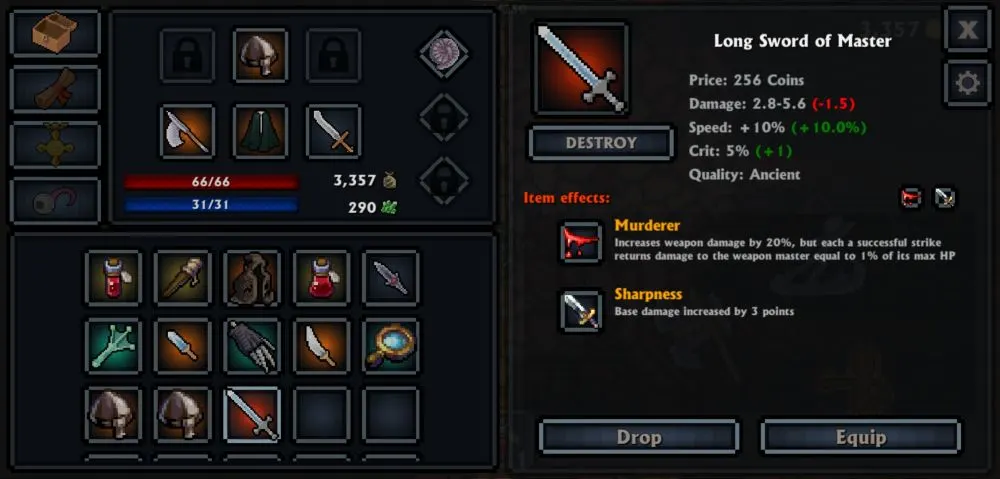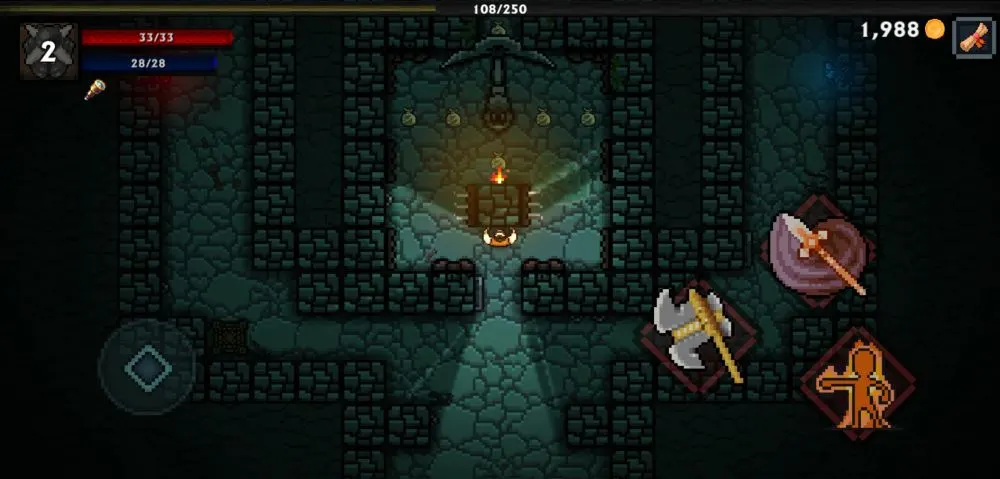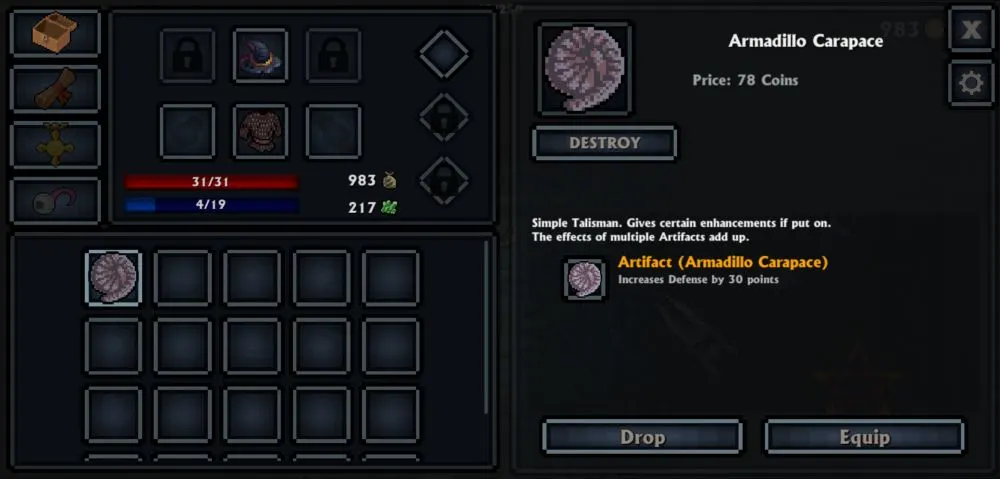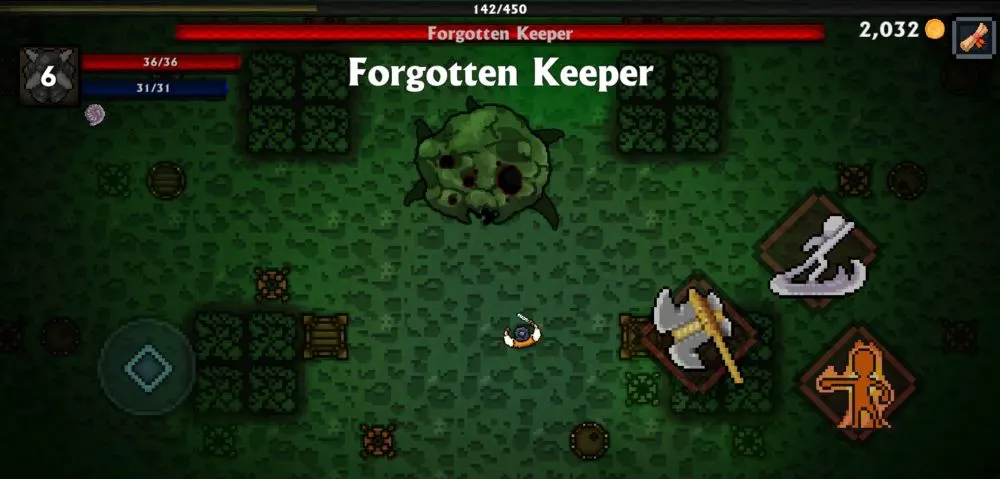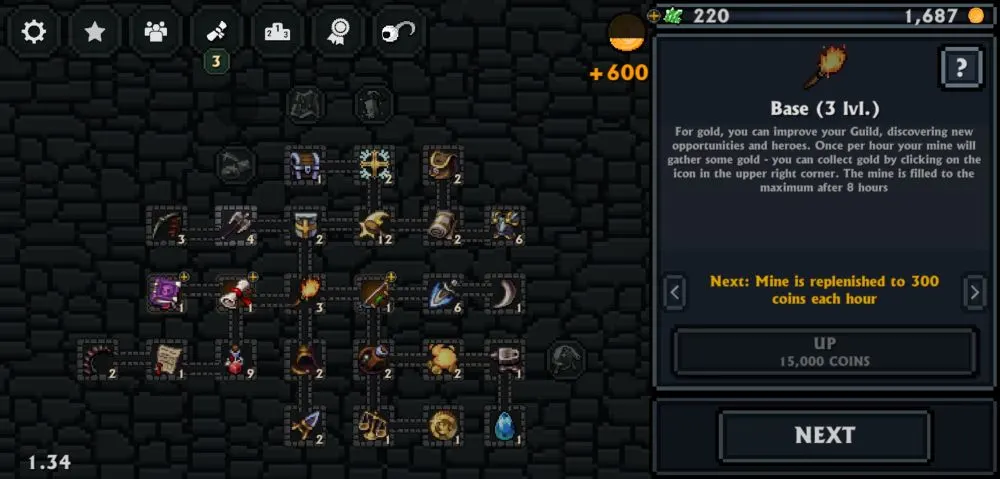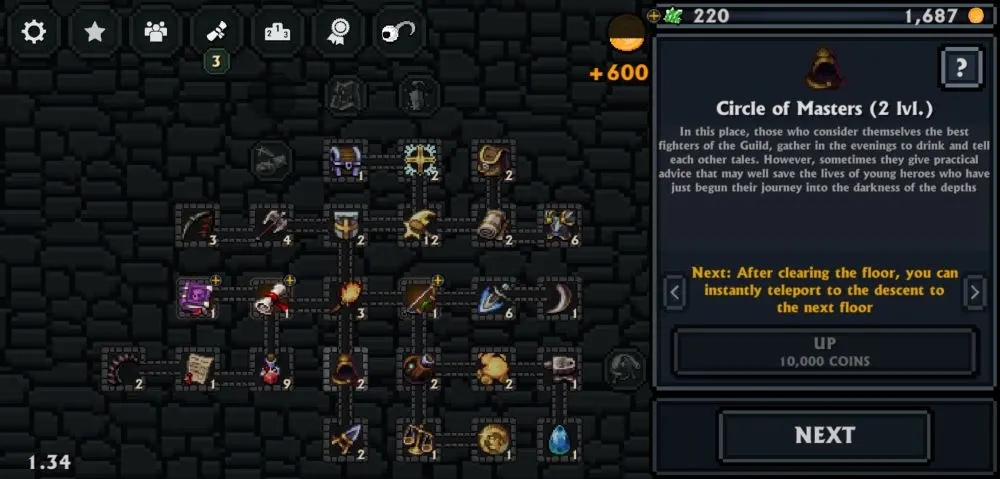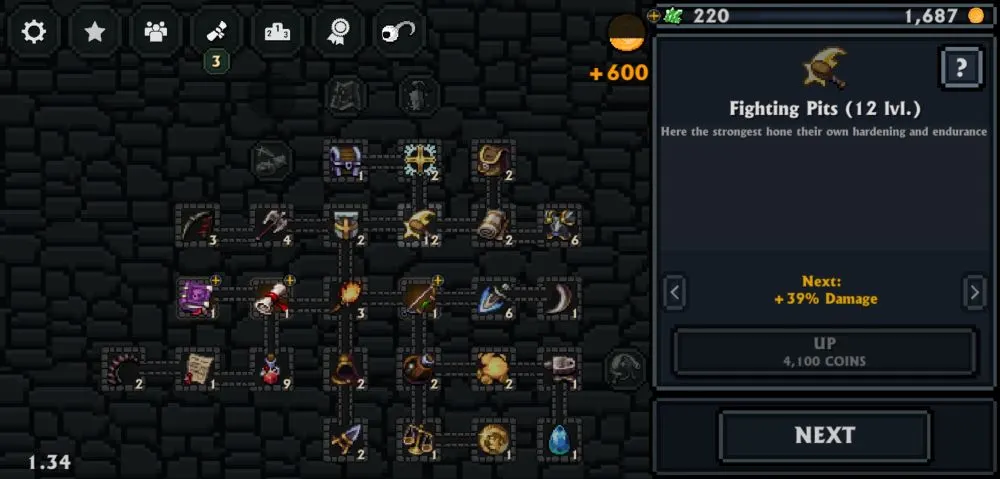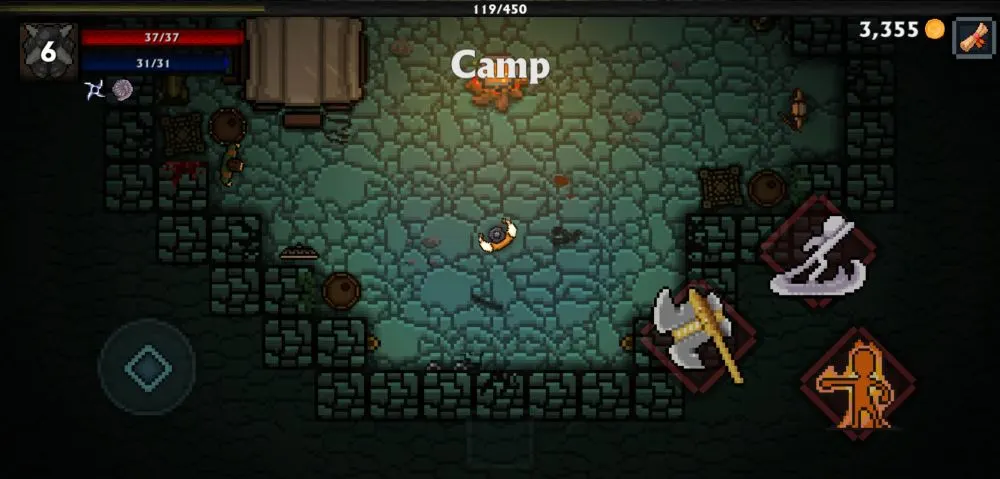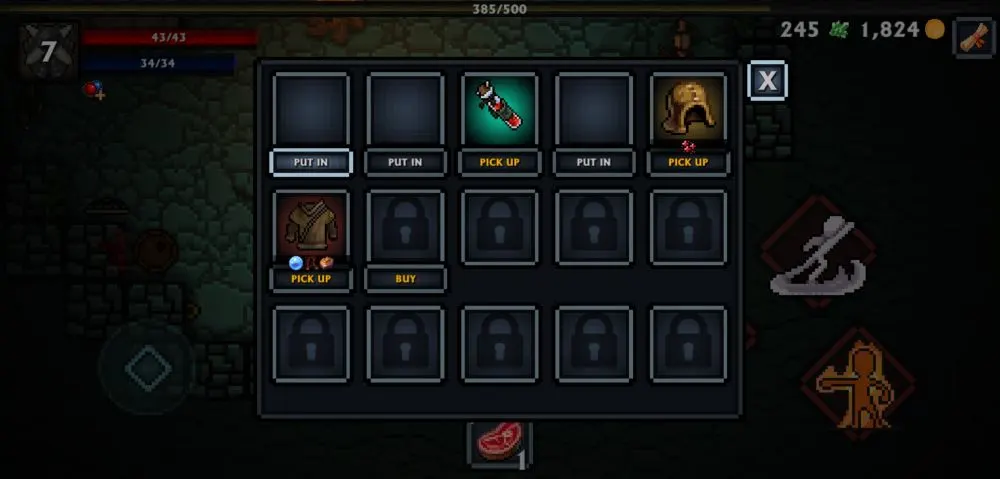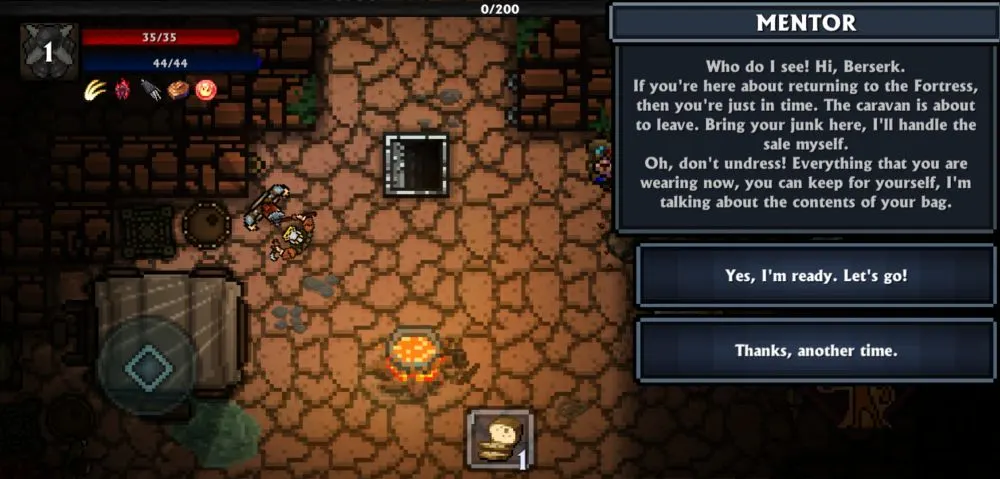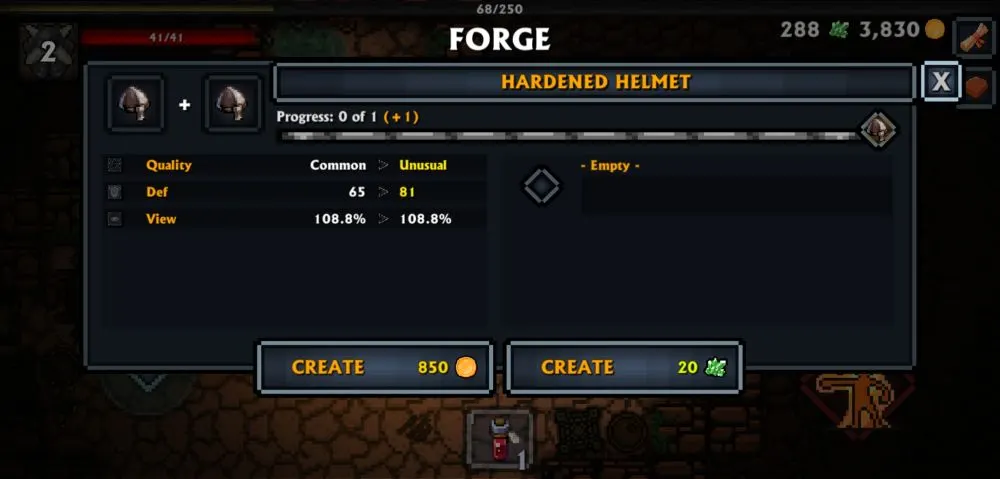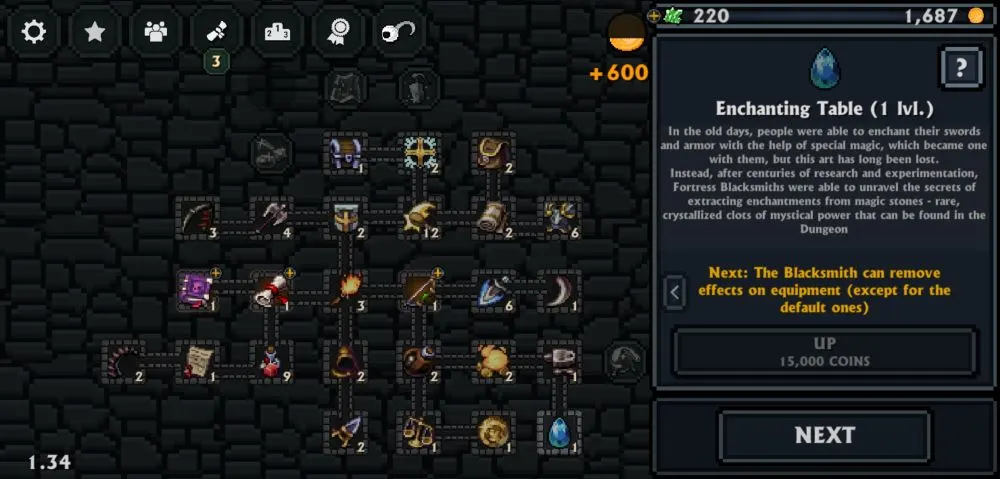Dungeons — from a distance they are massive structures that invoke terror in the hearts of the common man. From within echo the screams of the damned as well as those who die in ways that only their most horrifying nightmares could ever describe.
For the guild that you’ve been recruited in, these screams are an invitation. Do they tempt you to find out what happened to the tortured souls that ventured within? Are you willing to find out what secrets these dungeons hold? Will you look death in the eye and perish for a cause greater than your own? As bleak as this all seems, this is where you stand — before your destiny at the claws of the monsters that dwell within. Conquer ferocious dungeon monsters in the difficult game of Pocket Rogues: Ultimate.
EtherGaming’s entry into the roguelite genre is their very own Pocket Rogues. Pocket Rogues on its own is actually a demo whereas Ultimate is the paid version which unlocks everything else that isn’t in the vanilla Pocket Rogues. As Ultimate has lots content in it, we are aware that a lot of players may get quite intimidated by the game since dying is a normally inevitable occurrence.
But we’re here to explain why dying isn’t that bad and how you can (hopefully) minimize that as you delve into the dungeon’s demonic depths. The game is rife with secrets, and you’ll be able to explore them all by playing through the game.
Are you a new player hoping to give this game a try? Are you a struggling player that wants to get far because your frustration might be getting the better of you? Look alive, recruits, this article should be enough to carry you onward and help you not fear the horrors of the dungeon. Strap yourself in and let’s get yourself dirty, read our Pocket Rogues: Ultimate beginner’s guide below!
A Brief Intro to the Roguelite Genre
So we’ve mentioned the term “roguelite” a few paragraphs back. We’re sure you might’ve seen the word before but don’t know what it means. Otherwise, this might be your first time seeing the word entirely. Now we will start first with the question:
“What’s a roguelite?”
First, we delve into the term “rogue” which originated from an older game title aptly called Rogue. This game is a dungeon crawler that featured changing maps and permanent character death — dying meant having to start from the beginning. In its wake, a subgenre of games called “roguelikes” are games that mimicked the style of Rogue. They maintained a slew of the original game’s characteristics, but to summarize the prominent features of a roguelike, they had to have a couple of things:
- Turn-based combat on a tactics grid
- Permanent character death
- Lots of monsters to fight and kill, usually appearing all at once
- Procedural map generation (no two levels have the same map)
- Exploration, secrets, discovery, traps
- An inventory full of tools, equipment, and various other useful items
Notable roguelikes include Dungeons of Dredmor, 100 Rogues, and Cardinal Quest 1 & 2.
Roguelites are games inspired by roguelikes but feature a different spin to its gameplay. Here, they do away with the turn-based combat and instead come in a variety of gameplay styles such as side-scrolling RPGs, top-down action RPGs, and others. Aside from this, they also feature a “carry-over” system where, upon dying, certain things you may have earned can be used to improve the stats of every character you play, slightly easing up your next run little by little.
Roguelite titles worth mentioning are Soul Knight, Enter the Gungeon, Rogue Legacy, The Binding of Isaac, Wizard of Legend, Otherworld Legends, Hades, and Pocket Rogues — Soul Knight, Enter the Gungeon, and Binding of Isaac share a bullet hell shooter-like style, Rogue Legacy has its roots in the metroidvania subgenre, Wizard of Legends, Hades, and Otherworld Legends follow a similar style of fast-paced combat and dodging.
Pocket Rogues seemingly has its inspiration from difficult games like Dark Souls (down to the stamina system), somewhat being close to a now-defunct Souls-like* roguelite called Necropolis except done with a top-down view.
The mentioning of this carry-over system is important since it plays a huge role in any roguelite game and Pocket Rogues is no exception.
*Souls-like — (n.) A subgenre of action RPGs that mimic the gameplay of the notoriously difficult “Souls” titles developed by From Software. These types of games prominently feature exploration, clunky combat mechanics, a stamina system for movement and attacks, and an overall tough difficulty.
Pocket Rogues in General (AKA How I Learned to Stop Worrying and Love the Pain)
So what does the carry-over system have to do with the game? We’ll get to that soon in this section. An introduction to Pocket Rogues’ gameplay should ease you in on what you are to expect.
Let’s address the elephant in the dungeon room: dying is a completely common and normal occurrence in this game. You will die experimenting with things, you’ll die accidentally attacking a button that will suddenly spring a trap, you’ll die when the green bar fills because you’re suddenly poisoned, you’ll also die when you realize that the enemy horde is too big and you might’ve bitten off more than you could chew.
Death is everywhere, so don’t get too attached to your character. The best thing about dying, in particular, is it’s a way for you to assess your mistakes and take all the gold and crystals you earned with you back to the Fortress. This is the only means you have of making your character stronger apart from spending skill points, but we’ll discuss this extensively as the guide progresses. This is the carry-over system that we’ve mentioned before and, as you can see, it bears quite an important part in the game.
As far as recognizing your mistakes, you may try to remember what killed you (since the game tells you how you died) and take note of how you can prevent it from happening again. A ridiculous example of this is having the writer of this very guide test the Dash ability, only to hit a wall of spikes, killing his character instantly. Ouch! (Good thing he just started his run then.)
Though, one thing that isn’t great about dying is losing all the items you found in the dungeon. There are, however, items that exist as blueprints for you to start with during your next runs. Good luck finding these.
The Anatomy of a Dungeon
Each dungeon has a set of randomly-generated floors. This means that no two floors neither have the same layout nor the same kinds of enemies, breakables, or traps within them. After a couple of floors, usually 5, you come face to face with a boss at the last floor. The defeat of this boss will open up a new area, as well as a chance for your surviving character to press on into more danger and certain death. Of course, your character’s survival mostly depends on your cunning and skill.
There may also be times when your next floor could either be a Treasury or an Ambush. An Ambush is potentially dangerous since it’s a room laden with spiky barricades, automated turrets, and monsters that want to redecorate the halls with your innards.
The Treasury, while it sounds more promising than an Ambush, is just as sadistic since it requires your character to navigate through a maze that verily wants you dead — it will most likely have spikes that line the walls, spike traps that operate in a sequence, dart traps that fire in intervals, and the occasional Fel Source that poisons you when you get too close. Did we mention that the Treasury is filled with lots of gold if you get through the traps? Pray to the old gods that your greed doesn’t take hold of your will!
The dungeons also have different spawns. For instance, you’ll face mostly the undead in your first dungeon, the Catacombs, and in the Lost Tomb, a gated dungeon. Keep an eye on the in-game tooltips, as they all mention how a type of monster behaves. To further elaborate, using the undead as an example, they cannot bleed nor be poisoned. Some pieces of equipment may also help you survive better against a specific type of monster. Keep those handy when you find them.
Monster behavior aside, you might also want to keep a lookout for enemies with yellow-colored names. These monsters are slightly more dangerous than others as they usually have higher HP and hit harder. But as high a risk as this may seem, they are also more rewarding to take down. These monsters drop an increased amount of gold as well as a number of crystals that have various uses. We’ll get to these later.
We’ve talked about what lives (or un-lives?) in the dungeon thus far, but what about the inanimate? We mean boxes, barricades, barrels, breakables — you get the idea. Not only are these satisfying to destroy, but they also help give you a clean path of escape if need be. Barricades, in particular, are troublesome since most of them are spiky. Colliding with any of these will surely hurt your character (or even kill them).
There are also some funny-looking containers that, when broken, release fire or a noxious liquid that poisons when you make contact with it. Despite these breakables being in the way of most things, they play a bigger role in the game as we’ll point out soon when you deal with bosses. The best kind of breakables you need to look out for are chests which are rectangular in shape — you can’t miss them.
Occasionally, you will find strange things on the walls of the dungeons. These can be torch holders, pipes you can crawl through, or even gates. Besides giving you more light and vision as you venture through the dungeon halls, torches actually help restore your health faster.
So long as you stand next to a torch while you aren’t being attacked by anything, you’ll regain your health at a quicker rate than usual. Pipes can be used as a means of escaping a horde of monsters or even finding a shortcut through the dungeon itself (these sometimes lead to the stairs downward).
The gates may vary between being Camp Gates and Boss Gates — Camp Gates give you solace and a place of reprieve while Boss Gates simply bring you pain if you aren’t ready for it. If the gate isn’t a Camp Gate, enter it at your own peril. These boss gates are also not the end boss of a dungeon but they drop cool that could help you get through a floor more quickly.
Lastly, there are a few other oddities in a dungeon — altars and hazards. Hazards could range from wall traps to acid pits. Certainly standing in these or in the way of these means your unfortunate demise, but altars are a way of giving you a speedier run through the floor. The blessings that altars give you can range from a variety of buffs to summoning friendly monsters to your side. Using this while there are enemies around should be your best bet.
Some hazards, on the other hand, can be activated via the flip of a switch. While it’s wise that you shouldn’t do this while in front of the trap (you’ll figure it out one way or another), sometimes it helps because they damage any enemy that might be in pursuit of you. Until you’ve mastered how these powerful traps work, you’ll be able to dispose of any of your assailants if they happen to find you in a room with a manual trap.
Your Rogue and You
Almost everything you make your character do depletes their Mana by a little bit; some actions require more Mana than usual. Balancing this out is your first step. Most notably, your basic attack, your skills, running, and dashing are the things that consume your mana the most.
With all this mentioned, don’t wantonly spam your buttons. You won’t know when you’ll need that emergency dash and you won’t know when you’ll need that extra mana for an attack to clear the enemy out. As there are character classes, the consumption of Mana greatly varies.
Picking a class is a matter of trial and error. Each class in Pocket Rogues is unique in that they all have their own means of surviving or killing enemies. To sum it all up, we can describe each class by categorizing them below:
- Survival — Warrior, Necromancer
- Single-Target Damage — Archer, Hunter
- Multi-Target Damage — Berserker, Wizard
If you intend on surviving for longer periods of time, pick the Warrior or the Necromancer. Do you fancy picking off enemies one by one and ending bosses quickly? Try the Archer or the Hunter. Does bathing in the enemy’s viscera bring you joy as you destroy more of them with your skill? The Berserker and the Wizard are ideal for you. This is all a matter of preference to the player as every player has their own playstyle. Don’t be afraid to experiment either — your favorite class might be unlikely!
The various character classes also have stats they specialize in. Increasing these stats based on your class of choice is very important as they grant the specializing class with bonuses unavailable to other classes. Below are the stats and the classes that benefit from them:
- Strength – Berserker (extra damage and resistance against abnormal statuses)
- Endurance – Warrior (extra HP and faster HP regeneration)
- Agility – Archer and Hunter (extra move speed, attack speed, and resistance against abnormal statuses)
- Intelligence – Wizard and Necromancer (extra MP, faster MP regeneration, and defense)
Focusing on these stats based on the character you mainly play will make them more powerful at a speedier rate. Before you know it, you’ll be dealing with bosses like they were regular enemies.
Now that you know how Pocket Rogues plays in its entirety, let us now proceed to the tips section of our guide.
Combat Tips
It goes without saying that combat plays a big part in Pocket Rogues. You’ll be facing off against the ferocious, fierce, festering, and fiendish. This part of the guide takes on an approach that befits any player using any class. Read on!
1. Fight on the Move
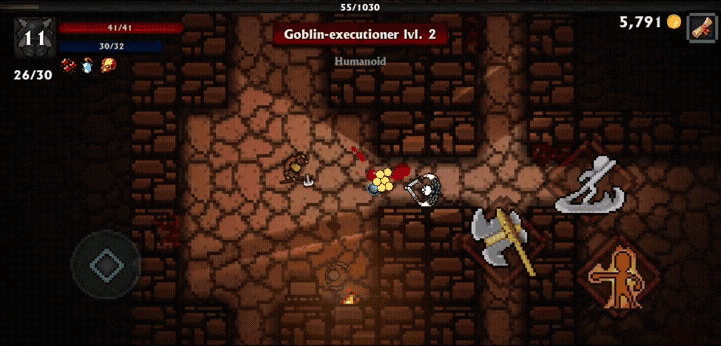
Granted that Pocket Rogues doesn’t adhere to the traditional turn-based movement scheme, fighting in this game is a lot freer. You can move to the side, avoiding swipes from the enemy, move away when there are too many, and the like. Fighting on the move is very important.
Aside from keeping your character safe (even the melee ones), this allows you to study the layout of the room. While this doesn’t feel like you’re doing much, each hit staggers the enemy backwards, resetting their attack animation every time. This doesn’t happen to all enemies, but it’s enough for you to at least keep out of harm’s way.
You may also lure them into places you’d want them to be as we’ll point out soon. This tactic is most advantageous if you are using a ranged class like the Archer or Hunter that easily fire projectiles at the enemy. The limitations present themselves only when you fight monsters that are able to lunge at you like Ghouls.
Moving around also means a chance for you to escape. Long-pressing on a blank portion of the screen makes your character run in the direction you’re pointing the joystick. While this also consumes Mana, it helps you get away from monsters if the horde has become too crowded. Getting mobbed by monsters is never a great way to go.
In some cases, you will encounter mechanisms (e.g. Stone Guardians) that will fire projectiles at you. Unless you are using Warrior with a shield during that encounter, dodging these should be your best course of action lest you block the flying spikes with your face. Not only will you avoid becoming a pin cushion, you’ll also find a great way to get in close and disarm (AKA destroy) the mechanism. Just don’t try this on dart or blade traps — they cannot be destroyed.
Because moving around helps you survive plenty, there are two places where you can maximize your kill count. After all, you can’t die if the enemy is dead.
2. Use Corridors and Corners to Your Advantage
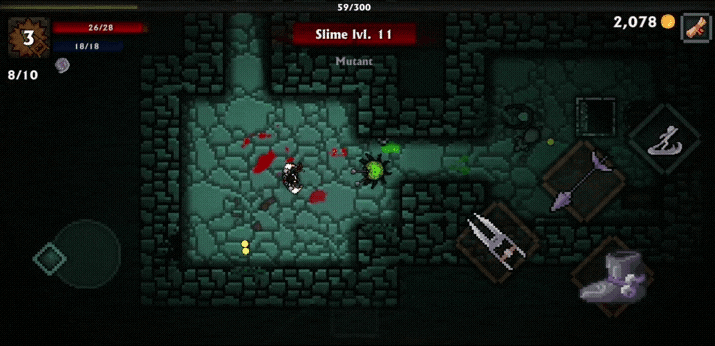
In some famous battles, strategists would consider funneling the enemy through small gaps in the landscape. The purpose of this is to slowly whittle at the enemy’s numbers and hopefully, ruin their ranks. The same thing can be done here in Pocket Rogues.
Luring enemies into corridors will help you take them out one by one. This will require you to back away further into the corridor, but kiting* them will nonetheless require you to hit them repeatedly. Melee attacks will make the kiting still viable, but these have a much shorter window since the monsters often close in very quickly. Most of them are very fast. That said, this is more a viable tactic for ranged classes.
Melee classes can use corners instead, but not to get themselves cornered. The melee class will lure the monster into the corner, then slowly move away from it, giving them more freedom to move around in the room they’re in. This is even more useful in larger rooms where there’s plenty of space to dodge your enemy’s attacks. Naturally, grouping them together also helps, especially if you play Warrior or Berserker since your attacks sweep through the enemy easily. Chipping at their health with every strike should thin the crowd very quickly, giving you a bigger chance of escaping.
This doesn’t mean you should blindly move about, however. There are still hazards present, as we’ve pointed out above.
*Kiting — (v.) A method in some video games where the player “pulls” an enemy, commonly an NPC, toward them by repeatedly moving further away whilst attacking, as though the player were running and pulling a kite. The above GIF demonstrates this.
3. Try to Avoid Traps as You Fight
There is the inevitability of encountering traps along the walls when you explore the dungeons is an uncommon occurrence.
You’ll find all manners of dart traps, spike traps, blade traps, fireball traps, and many others as you wander the haunted halls of every dungeon — some activated, some deactivated.
Surprisingly, these traps can actually be used to greatly damage your foes if you happen to lure them there, if you don’t get hit by them yourself. Bringing your enemies to the traps is a great way to kill them off without having to use any of your Mana. The caveat here is actually getting hit by them hurts. A lot.
When you see a trap, and unless you know what you’re doing, don’t come close to it. You’re better off saving your character’s skin than pulling off mad stunts to thin an enemy horde. There will be times when traps are indeed necessary, but sometimes taking such risks can come at the price of your character’s life. Your progress through the level will be for naught.
At the same time, it’s best to keep your eye on the floor while you move about. Stepping in Mutant blood or acid pits will be the least of your worries once you see mysterious sigils etched into the cobblestone floors. These sigils are mines: red ones explode and green ones produce a noxious gas. After stepping on them, they have a short activation delay that gives you enough time to escape. Otherwise, don’t step on these if you want to keep your run.
You know what else might count as a trap? A seemingly innocent statue. No kidding!
4. Never Trust a Statue
What unnerves you most about a statue?
Is it the way they look at you? Is it how you’d think that they might actually be looking at you? Is it that they might be following you as you move around them? How about the sounds they make? … Okay, real statues don’t do that (maybe), but the dungeons of Pocket Rogues tend to bring these fears to life.
Whenever you see a statue, treat it as though you would a breakable: destroy it. Destroy it and leave none of it standing. This is especially important if you explore the Lost Tomb. You will find that this place is littered with all sorts of statues, many of them appearing like hooded beings.
While one statue stands out among them all, a demon called the Weeping Statue, most other statues will attack you if you happen to make contact with them or stand directly in front of them. They will unleash spikes from every part of their body in an attempt to impale you, but if you smash them before they get the chance, you should be safe.
Therefore, if you happen to encounter any statue anywhere else, try to destroy it as much as you can. You’d be glad to have done so and it might just save you from getting killed (and/or a jumpscare). If they appear in a line in a corridor, smash them all so you can pass. It will take some Mana out of you, but it’ll be worth it.
Now for actual enemies, how do you think you’ll open up the fight? Buff yourself up!
5. Buff Up and Check Your Gear Before Engaging
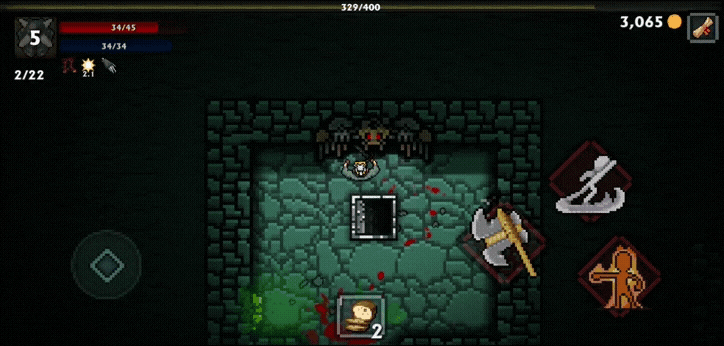
How do you approach your enemies? Charge in and hope your equipment carries you through? Do you shower yourself in Attack and Defense Ups before clashing swords? Take the latter approach here!
Buffing up before any engagement is just like what you do in real life. Before an important meeting with your boss, you psych yourself up and prepare to listen or present facts if you’re the presenting party.
If you happened to get in trouble with your parents, you’d try to keep yourself calm and collected before letting them know everything that happened. When any of us proposes to a significant other, we take deep breaths before popping the question. That’s how it works in an RPG as well.
Buffing yourself up with anything you have at your disposal is a very important thing to do before charging headlong into the horde’s bladed embrace. Not only should the buffs make you outlast them, they also help you get rid of any and all enemies faster. This tactic will most certainly keep your character alive for a bit longer.
Certain skills like the Berserker’s Rage ability, if you play Berserker, can easily prep you for a fight. The extra buffs it grants to the Berserker make them meatier and more dangerous to the enemy since they gain an attack up and damage absorption. Some items also carry some stat-enhancing properties with them.
The Grindstone, for example, will make any physical attacks hit harder after use. All that these require on your part is you to read their descriptions before you use them. Here are a few more examples of other things that can buff you:
- Step Into the Darkness (Archer) — Slows the Archer’s movement but gives them a chance to hide from the enemies. Can also be used by any class wearing the Half Mask.
- Magical Shield (Wizard) — At the cost of their Mana, the Wizard wraps a magic shield around their being that absorbs oncoming damage.
- Rapture of the Battle (Berserker) — The Berserker heals after slaying each enemy.
- Battle Madness (Berserker) — The Berserker’s defense lowers while their attack power is drastically raised. They also gain even more damage per every enemy they slay.
- Large Health Decoction (Item) — A potion that temporarily grants its drinker a higher HP max.
Granted that these are buffs, they are most certainly temporary; they only last a few seconds. You can also use these before venturing down a floor or entering any boss gates, saving you from performing the sometimes lengthy buff animations. While it does seem ideal to buff up while you’re in a fight, you’ll be giving the enemy a few hits in, so buff up before the fight itself!
We suppose that it goes without saying that when your health is in the pits, there’s no excuse for you to chug a health potion or eat food. Same goes for Mana when you’ve exhausted a lot of it that you can barely execute any of your skills.
This action will prepare you for your fight ahead and will also reduce the chance of you dying out immediately (because death comes for any class that sets foot into the dungeons one way or another). This will also be made easier to use after you gain quick slots from the Tailor, but this is something we’ll talk about much later.
Along the way, you will definitely encounter Unusual or Ancient gear. These items are powerful, but some of them could be painful to wear. For instance, you might encounter a Loincloth with impressive effects (like being able to recover whilst standing in a pool of blood) but since it’s just a Loincloth, well, let’s just say that it wouldn’t protect you much from attacks.
As much as possible, wear gear that complement each other with their effects. For instance, if you have some equipment pieces with the Battle March effect all stacked together, you will be able to move around quicker while in a fight.
That setup’s quite ideal when you play a class that favors ranged combat. But there are also some items that can stand on their own with their raw stats (e.g. Black Dagger), so take a look at what they offer and decide on using them. The results may surprise you when you actually put them to use. There is one peculiarity you will notice when you put a helmet on, though.
Notice how the camera zooms in or zooms out when you change helmets. This is called Vision — Vision is a stat that affects how much or how little your character can see (for anyone that plays tabletop RPGs out there, this is equivalent to Perception). What you see in your character’s surroundings interprets what they are currently hearing, seeing, and possibly even smelling in the rooms around them.
When your Vision is heightened, you’ll be able to see more of what might be around your character: where the exit is, what traps lie ahead, if there are dangerous enemies headed your way, etc. There is, however, an Artifact called the Monocle that removes any vision penalties.
Artifacts, you ask? They’re little trinkets that go in your Artifact slots. For hefty sums of gold, you can upgrade the numbers of which you can carry these. As little as they might be, these items are quite powerful and can provide you with very practical boosts.
For instance, Bandages slightly increase your recovery rate — equipping these and waiting for time to pass if you don’t have the Circle of Masters upgraded (more on this later), will allow you to start the next floor with a full bar of health. There are also the Beast Claws, which give you an overall damage increase. Who wouldn’t want this? Just like your gear, make sure that the Artifacts you have complement your overall “build” for your run.
Now that we’ve covered the majority about how you’ll tackle the evils that lurk within the dungeons, it’s time we address the big fishes in the pond.
Boss Tactics
Bosses in roguelites are the bane of many players. They’re the hurdles that oftentimes force the players back to the start because they’re too high to jump. But we’re here to make sure that you’ll be ready enough to tackle them. Though, we do have to warn you that it’s likely that they will kill you on the first few tries. Frustration is the enemy here, so let’s provide you with ways you can power through a boss fight and minimize the salt you gain from dying.
1. Observe the Boss at a Distance
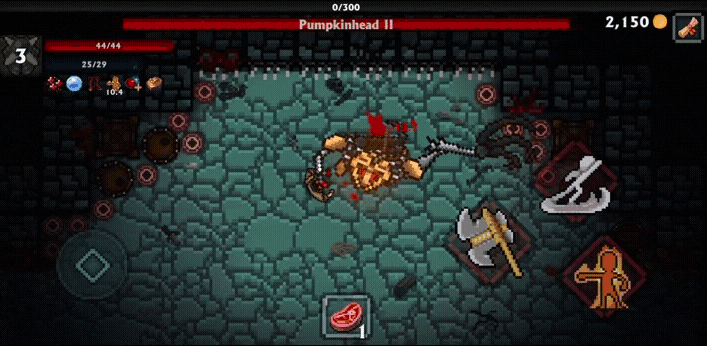
This almost requires no explanation; almost every boss out there has an attack pattern or a certain behavior.
A boss’ attack is usually telegraphed, giving you enough leeway to move out of the way or hurt them somewhere vulnerable like behind. Be on the lookout for audio-visual cues like roaring, moving backward, shaking, or anything that looks off about them. When they do any of these, chances are, they’re going to attack you somehow.
There are also some things that you may notice about the boss as you observe them without having to get too close. Sometimes, they won’t bother attacking you if you get to a certain distance. Otherwise, they will have to get closer to you and find a way to hurt you. Different bosses have different behaviors and you can exploit these when you finally figure out how they tick.
With their cues now in plain view, it’s time to work around them — almost quite literally.
2. Dodge!
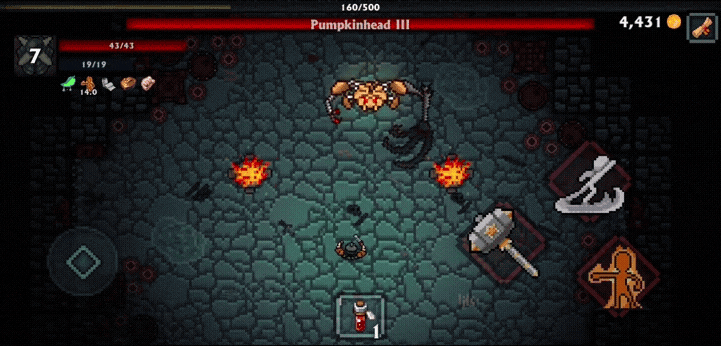
What does this game have in common with other difficult games such as the Monster Hunter series or any Souls game out there in the market today? Dodging saves your life.
We will discuss where the Dash skill itself comes from later, but let’s talk about how practical dodging can be. In an instant, you can zip away from a boss’ attack or evade traps in their own arena by using the Dash. This maneuver should be enough to carry you through a boss fight, but be careful not tododge into a boss’ attacks or a trap. It’s easy to get a little carried away when dodging and it’s even easier to run out of Mana doing it.
It’s important to stay calm and follow the previous item in this section. Only dodge if you feel like you’re right in the path of the boss’ attack path. If you dodge in a panic, it’d be a waste of Mana — a waste of time waiting for the Mana bar to recover, a waste of time trying to buff yourself or use a powerful skill. Some attacks can be easily avoided by walking away from them, but dodging is always a safer option. Just don’t rely on it too much, or you’ll be scrounging for a Mana potion.
With the boss’ movements basically at your fingertips, this is the part where you figure out where to strike.
3. Attack at an Opening
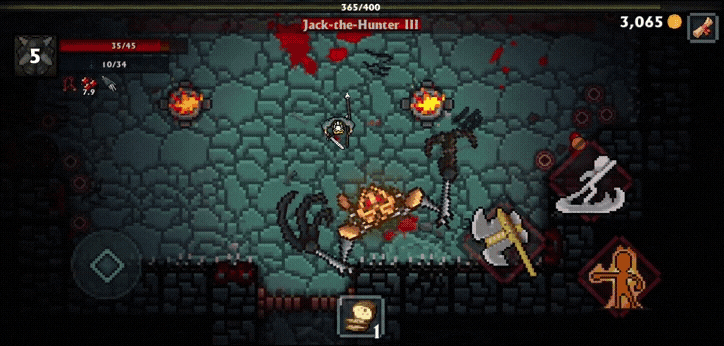
When the big boss rears its ugly head and readies for a big attack, do you back away and let them do it? Don’t. This could be your opening for an attack.
Prudence in your fight with the boss can go a long way, especially if you’re a class with lower HP than others. It’s not wise to rush at the boss and strike them as though they were a mere damage sponge. This can spell doom for your entire run, especially since the bosses hit really hard when their attacks do land. Find little openings whenever they attack and strike back with just enough ferocity that will allow you to back off right away.
While this is easier said than done with melee fighters like the Warrior and the Berserker, they can get their fair share of hits, too. The key here is the Dash skill. Once you see the boss’ audio-visual cue, this is when you Dash away and let them do it. Otherwise, you’d have to be constantly in the boss’ face giving them what for.
For certain, longer attacks, you may have to make a Dash for the back of the boss, since it will take them a second or so to turn around. In other words, give the boss a good spanking.
There is the certainty that you will get hurt by the boss’ attacks, however. When you’re out of potions or you’d like to conserve them, here’s what you can do.
4. Let the Boss Destroy its Own Arena
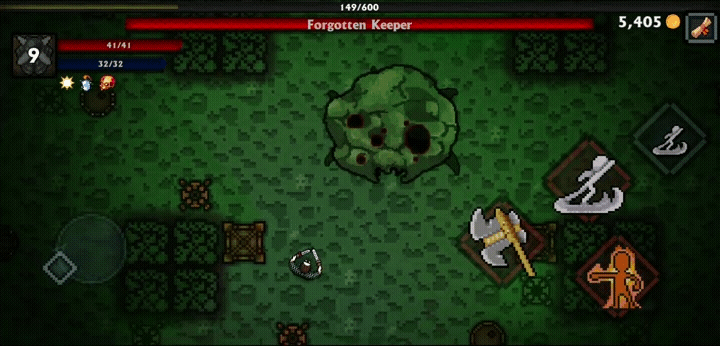
The boss has a terrible time managing its own anger, especially when it’s out to get you. What can you do to help them? Let them destroy their own arena!
That’s right. A boss arena is bound to be littered with boxes that drop pickups — health or Mana orbs should pop up when any of these crates and barrels are destroyed. It’d be a bit difficult for you to do it since while you’re fighting the boss, your character will be constantly locked on to them. That said, having the boss destroy these themselves is the best way to go.
Apart from drops, some bosses can actually thwart themselves by destroying certain things. Let’s take the Forgotten Keeper for example — in its arena, it has a small number of explosive barrels about. The barrels, when destroyed by the Keeper (or you) ignite the floor for a short amount of time. This burns the Keeper for a short amount of time but deals enough damage for you to be able to bring you closer to victory.
Aside from this, some of the barrels can be pushed (by moving toward them) closer to the spike trap. The spike trap will repeatedly skewer the Forgotten Keeper while it gets burned. Just be careful not to get skewered yourself.
When the boss has sustained a certain amount of damage, they perish, leaving you alone in the room. Don’t head to the exit just yet.
5. Loot the Room Before Leaving
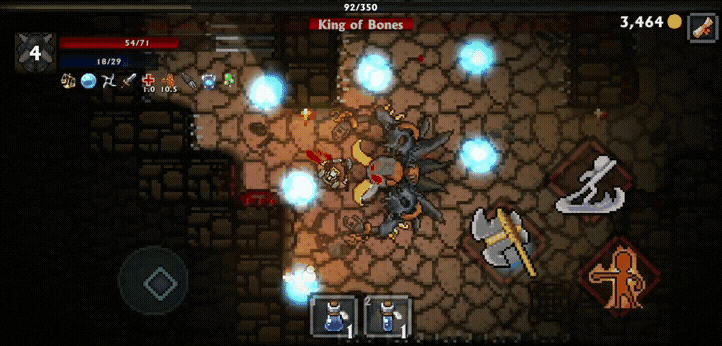
We believe this is standard RPG protocol at this point — the boss is dead, and now it’s time to take their hoard of treasure.
After slaying the boss, you’ll notice one thing very quickly: the boss room becomes the safest room in the entire game for the duration you’re there. All the traps get deactivated, no more off the boss’ flunkies pop up out of nowhere to kill you, it’s all a moment of reprieve for you while you prep yourself to go to the next floor.
While it’s quite tempting to head to the exit and continue on with your quest, it really helps to just loot the room after offing the boss. You’re most likely to find their loot somewhere in the sides or corners, in chests that you need to break open. The contents of these chests vary, but they’re most likely equipment or artifacts. Who knows what you’ll find? You might be able to get enough of these to help you power through the next floor.
If you don’t have the Circle of Masters upgraded yet, you may also break open the rest of the barrels and boxes for health/Mana orbs. Don’t waste your potions by restoring what health or Mana you lost, maximize your time in the boss chamber before leaving.
If you happened to break all the boxes and picked up what was inside them and you still need to recover, wait a little and let your health and Mana regenerate naturally. Do know that some boss rooms may have torches in them and thus, standing next to them helps you regenerate these bars much quicker.
We’ve discussed all what makes the game so tense so far, so how about some R&R? Or shall we say R&D?
Fortress Maintenance
Every rogue needs a home to come back to (especially if you find the Camp and speak to your Mentor there). The Fortress is a place that can give you stat boosts, add-ons, and more. All these little upgrades give a big impact to any and all of your runs provided that you choose well on what to upgrade. Always remember that each upgrade is more expensive than the last. Our recommendations on what to prioritize are below. Read on!
1. Invest in Dash and Circle of Masters First
At last, we finally reach the part where we talk about where the Dash comes from.
For the low, low price of 3,000 gold (yes, that is low), you can give your character the ability to Dash early on. Grinding for this amount in the early game could be difficult, but trust us when we say that it’s worth it, especially with what comes next.
The Circle of Masters then pops up. This powerful, powerful upgrade gives you the ability to restore all your health and Mana every time you complete a level. This is no doubt more expensive than the Dash upgrade, but this is all the more worth it. Imagine having completed a level and your rogue is seemingly covered in their own blood. A small, angel-like icon will appear right below your health and Mana bar. Tapping that will completely recover your rogue.
The next upgrade of the Circle of Masters can wait (it teleports you immediately to the exit of the level after you clear the floor), but let’s go for more important nodes.
2. Mostly Focus on Stat-Boosting Nodes
Passive bonuses in an RPG. Who doesn’t love them?
They may feel like they aren’t there, but you’ll feel it once you actually put yourself in the shoes of your character. More HP means tanking hits from the enemy, more damage means killing the enemy faster, more MP means more skills to perform, etc. There are quite a number of nodes in the Fortress that can do that for you, and when you have any gold to spare at all, you should use them here. These will definitely help you have smoother runs.
- Fighting Pits — Increases damage by 3% with each upgrade.
- Medical Corps — Increases max health by 3% with each upgrade.
- Duel Club — Increases defense points by 1.5 with each upgrade.
- Training Field — Increases max Mana by 3% with each upgrade.
- Assassin’s Guild — Increases critical hit damage by 1.5% with each upgrade.
- Monsterology Guild — Increases critical hit chance by 1.5% with each upgrade.
What you will prioritize here is entirely up to you, especially since we suggested to you earlier to pick a class you’d like to specialize in. To further elaborate, if you enjoy using Warrior or Berserker, try focusing on the Medical Corps and the Duel Club since most of the time, you will be fighting your enemies up close and taking hits.
Likewise, if you use either Berserker, Hunter, or Wizard, the Fighting Pits or the Monsterology Guild could be a must for you. Bottom line is each of these upgrades affect and greatly benefit all classes; the order of which you upgrade them is your choice to make.
The Camp node is another upgrade worth mentioning since having the camp will allow you to go through your adventure with caution (and lots of bonuses).
3. Slowly Build Up the Camp
Upgrading the Caravanserai node (which looks like a bonfire) will give you a small percentage to encounter the Camp gates on your journey. The Camp gates look like a plain entrance with a cobblestone lining. Upon entering the Camp, you’ll be greeted with a space for reprieve within the cold, cruel halls of the dungeon. But don’t make it just a space for reprieve; furnish it with a couple of things here and there.
a. Personal Chest
The Personal Chest is a special box which you can deposit some rare finds in. This chest is actually more useful to the next rogue that takes the place of your current one.
If you’re willing to prepare your rogue’s successor for what’s to come, time to put in a potion or two and that rare sword that you found a while back. They’ll thank you for it. Be warned that expanding the space of your Personal Chest will cost crystals.
b. Cauldron
This item is the heart of the Camp. Investing in the Cauldron will make a large pot of boiling soup appear in the middle of the Camp with a warm and cozy flame. Staying near the Cauldron will slowly regenerate your character’s HP. If you draw yourself close enough to the Cauldron itself, you will be given the option to drink the soup. Doing this will briefly increase your max HP.
c. Merchant
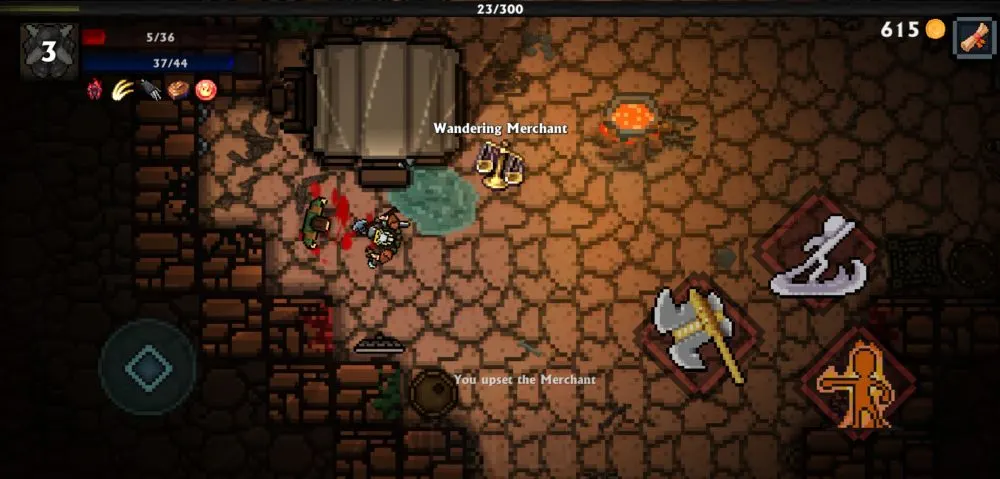
This man can take your items and sell them for gold. He is, at most, useful for clearing out your inventory without having to drop any item on the floor. At the back, you’ll notice that he has a personal chest with him. Try not to break this open even though it may or may not have a special item inside (*wink wink*).
If you do, he’ll refuse to transact with you while you are in the camp. If you invest in the Middleman upgrade, the Merchant will buy your stuff off of you for an increased price.
d. Blacksmith
The Blacksmith can help create new, Unusual items from common items of the same class (e.g. Sword and Sword, Dagger and Dagger, Breastplate and Breastplate, etc.). If you happen to be carrying two of these, give it a try.
For him to fuse two Unusual items and turn them into Ancient ones, you may need to upgrade him first. Combining two identical items (e.g. Short Sword and Short Sword) will give that item a slot for gems. But this will need an…
e. Enchanting Table
This last, important item is an upgrade to the Blacksmith’s workspace. The Enchanting Table is where you can give the Blacksmith a slotted item and a gem for him to inlay. Doing so will grant the item a powerful perk. Each gem has different effects, so keep trying them on different pieces of equipment!
For an RPG, this game has a lot of stuff but quick slots… But what if we told you that quick slots exist?
4. Upgrade the Tailor for Quick Slots
Seeking out the Tailor in the Fortress will give your character quick slots for usable items.
Without quick slots, you will have to open your bag every time and rummage through your inventory — it’s messy, it’s slow, it’s inconvenient. But with the Tailor, we’d like to think that maybe he might’ve sewn a couple of secret pockets into your rogues’ uniforms… Well, okay, maybe just one secret pocket on the first upgrade.
Having quick slots will allow you to easily drink potions on the fly, especially while you’re fighting the boss. It doesn’t break your concentration and it doesn’t make you lose your flow. It can also hold items like throwing knives that can be used to damage enemies (or the boss) at a distance if you’re a melee fighter. Consider investing in this humble upgrade.
Last but not the least, let’s focus on your favorite class and how you can make them even better than before.
5. Upgrade the Buildings of your Favorite Class(es)
You got us: we can’t stress enough how you should have a favorite class in this game.
This is a usual bias for many RPG players. Some of us have the inclination to play the mighty Warrior, others the mysterious Hunter. There are players that might prefer the very practical Archer, while some players would pick the more complex Wizard.
How about those who choose the destructive Berserker or the domineering Necromancer? It’s all a matter of preference. Regardless of what your preference is, how about putting points in them for their skills?
Every time you choose to upgrade the skills of your preferred class, you need points that you get from gaining levels. These points can be put in your class’ main stats but they may also be used in upgrading the class’ skills. The requirements of these points are equal to their level (e.g. a level 5 stat/skill will require 5 stat points to level up). But each of these skills can only reach a certain level cap.
The Fortress upgrades per class is as follows:
a. Warrior — Training Camp
b. Berserker — Halls of Battle
c. Archer — Archery Range
d. Hunter —Blades Hall
e. Wizard — Arcane Laboratory
f. Necromancer — The Secret Cathedral
Investing in upgrading any of these will allow you to put more points into the skills of your preferred class. Doing so will make your rogues even more powerful when they exercise these skills in combat.
We’ve withheld most of what the game has to offer since there are little secrets here and there. Spoiling the surprise wouldn’t be that fun, but let’s have a brief look at what you’ve learned from reading this guide:
- Move around as you fight. Utilize corridors, traps, and other things that might be to your advantage.
- Traps may work against you, so avoid them as you fight.
- Statues are suspicious. Never trust them. Destroy them on sight.
- Buff your rogue before any encounter whenever possible. Also keep your gear updated.
- Watch out for audio-visual cues when fighting a boss.
- Dodge the boss’ attacks by using the Dash skill and attack the boss when you see an opening.
- The boss arena is full of destructibles — let them destroy these to your advantage.
- Never forget to loot the boss room before leaving!
- When upgrading the Fortress, the Dash and Circle of Masters should be your first investment.
- Focus your upgrades on nodes that increase the stats of your rogues.
- Build the Camp slowly but surely. Don’t rush with these upgrades, a place for your rogue to rest should be enough in the beginning.
- All the rogues’ classes have a level cap for their skills. Upgrading these in the Fortress will increase the level cap allowing for more powerful skills in the future.
This concludes our beginner’s guide for Pocket Rogues: Ultimate! Are you, yourself, a seasoned rogue who has had many kills and many deaths under their belt? Do you have advice for the Guild’s newbloods? Is there anything we might have missed in this beginner’s guide? If you said yes to all of these questions, feel free to leave your thoughts in the comment section down below!

